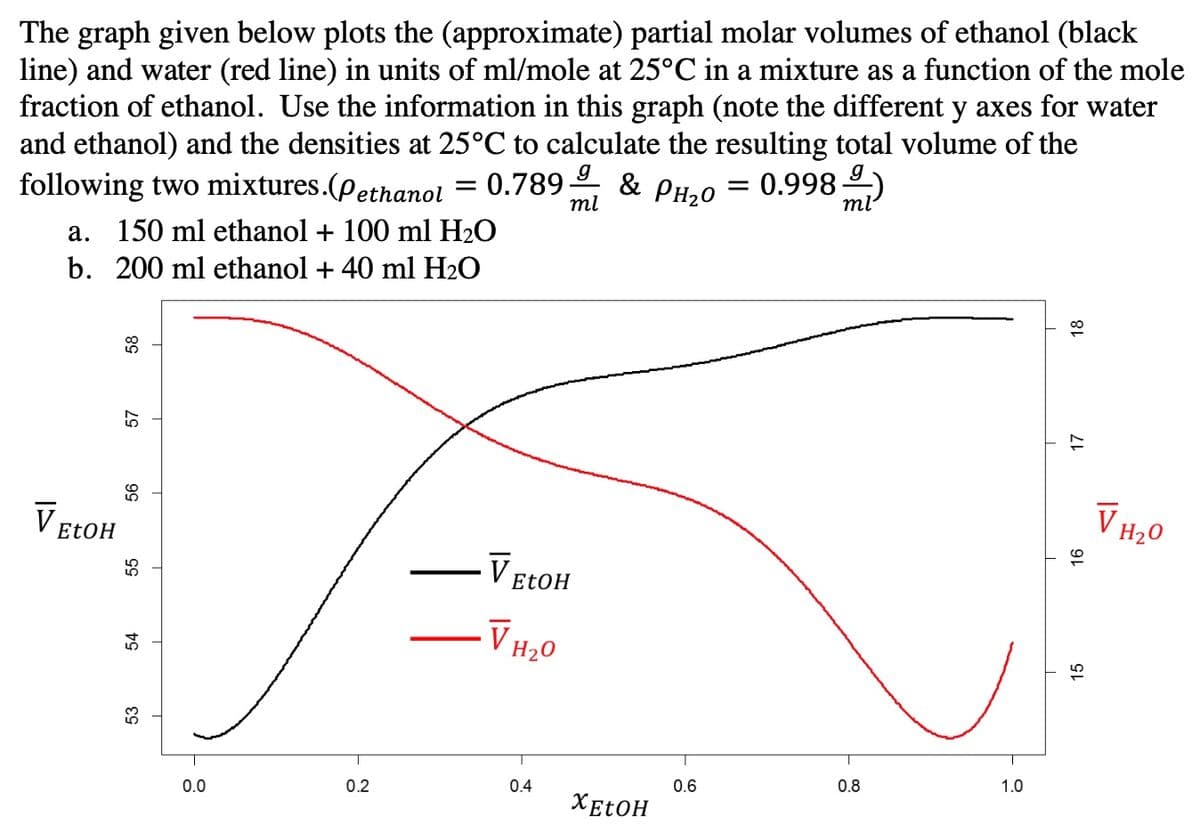The graph given below plots the (approximate) partial molar volumes of ethanol (black line) and water (red line) in units of ml/mole at 25°C in a mixture as a function of the mole fraction of ethanol. Use the information in this graph (note the different y axes for water and ethanol) and the densities at 25°C to calculate the resulting total volume of the 0.998 2) ml g following two mixtures.(pethanol 0.789 & PH20 ml a. 150 ml ethanol + 100 ml H20 b. 200 ml ethanol + 40 ml H2O 17 V H20 V ETOH 16 - V ELOH V H20 0.6 0.8 1.0 0.0 0.2 0.4 XELOH 53 54 55 99 15
The graph given below plots the (approximate) partial molar volumes of ethanol (black line) and water (red line) in units of ml/mole at 25°C in a mixture as a function of the mole fraction of ethanol. Use the information in this graph (note the different y axes for water and ethanol) and the densities at 25°C to calculate the resulting total volume of the 0.998 2) ml g following two mixtures.(pethanol 0.789 & PH20 ml a. 150 ml ethanol + 100 ml H20 b. 200 ml ethanol + 40 ml H2O 17 V H20 V ETOH 16 - V ELOH V H20 0.6 0.8 1.0 0.0 0.2 0.4 XELOH 53 54 55 99 15
Chemistry
10th Edition
ISBN:9781305957404
Author:Steven S. Zumdahl, Susan A. Zumdahl, Donald J. DeCoste
Publisher:Steven S. Zumdahl, Susan A. Zumdahl, Donald J. DeCoste
Chapter1: Chemical Foundations
Section: Chapter Questions
Problem 1RQ: Define and explain the differences between the following terms. a. law and theory b. theory and...
Related questions
Question

Transcribed Image Text:The graph given below plots the (approximate) partial molar volumes of ethanol (black
line) and water (red line) in units of ml/mole at 25°C in a mixture as a function of the mole
fraction of ethanol. Use the information in this graph (note the different y axes for water
and ethanol) and the densities at 25°C to calculate the resulting total volume of the
g
following two mixtures.(pethanol
= 0.789
ml
& PH20 = 0.998 )
ml
a. 150 ml ethanol + 100 ml H2O
b. 200 ml ethanol + 40 ml H2O
H20
VELOH
Vet
o*HA
-V ELOH
V H2O
T
0.8
1.0
0.2
0.4
0.6
0.0
XELOH
53
54
55
57
15
18
Expert Solution
This question has been solved!
Explore an expertly crafted, step-by-step solution for a thorough understanding of key concepts.
Step by step
Solved in 2 steps with 1 images

Knowledge Booster
Learn more about
Need a deep-dive on the concept behind this application? Look no further. Learn more about this topic, chemistry and related others by exploring similar questions and additional content below.Recommended textbooks for you

Chemistry
Chemistry
ISBN:
9781305957404
Author:
Steven S. Zumdahl, Susan A. Zumdahl, Donald J. DeCoste
Publisher:
Cengage Learning

Chemistry
Chemistry
ISBN:
9781259911156
Author:
Raymond Chang Dr., Jason Overby Professor
Publisher:
McGraw-Hill Education

Principles of Instrumental Analysis
Chemistry
ISBN:
9781305577213
Author:
Douglas A. Skoog, F. James Holler, Stanley R. Crouch
Publisher:
Cengage Learning

Chemistry
Chemistry
ISBN:
9781305957404
Author:
Steven S. Zumdahl, Susan A. Zumdahl, Donald J. DeCoste
Publisher:
Cengage Learning

Chemistry
Chemistry
ISBN:
9781259911156
Author:
Raymond Chang Dr., Jason Overby Professor
Publisher:
McGraw-Hill Education

Principles of Instrumental Analysis
Chemistry
ISBN:
9781305577213
Author:
Douglas A. Skoog, F. James Holler, Stanley R. Crouch
Publisher:
Cengage Learning

Organic Chemistry
Chemistry
ISBN:
9780078021558
Author:
Janice Gorzynski Smith Dr.
Publisher:
McGraw-Hill Education

Chemistry: Principles and Reactions
Chemistry
ISBN:
9781305079373
Author:
William L. Masterton, Cecile N. Hurley
Publisher:
Cengage Learning

Elementary Principles of Chemical Processes, Bind…
Chemistry
ISBN:
9781118431221
Author:
Richard M. Felder, Ronald W. Rousseau, Lisa G. Bullard
Publisher:
WILEY